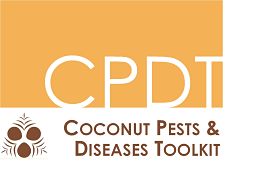Prevention of outbreaks
Sanitation and plant health are important to prevent outbreaks of pests and diseases. Extreme weather events can promote favourable conditions for disease outbreaks and transport pests to new areas. Movement controls should be in place to avoid transporting pests or diseases to new areas.
In this sub-section: Sanitation : Movement controls : Plant health : Weather and climate : Information sources and further reading
Sanitation
- The use of non-sanitised cutting and pruning tools can spread diseases between palms. If diseases such as Tinangaja are present in the area, cutting tools should be cleaned between plants.
- An effective treatment for viroids is to soak tools in a 1% solution of sodium hypochlorite for up to one minute. This can be effectively prepared from fresh household bleach products diluted correctly and used the same day. Rinsing the tools with plenty of water is needed to prevent corrosion.
Movement controls
- Never move palms or seeds or germplasm from infested / infected areas (See guidelines on transporting coconut genetic resources).
- The transport of live coconut tissue without regulation will increase the chances of spread especially since it is unknown if the disease is spread through pollen or seed nuts.
- Coconut can be a host to diseases of other plants (e.g. pineapple mealybug) and vice versa - take precautions when moving any plant materials. Seek the advice of your Agriculture department or SPC for information on other plants that host pests and diseases of coconut. Other palm species are common alternative hosts.
- Never move dung or composting materials to new areas as.
- Diseases can be transported in all live plant tissues (seeds, nuts and pollen). The only way to ensure they are not spread is to ban their import or domestic movement.
Plant health
- Coconut growing conditions should ensure nutrient levels are optimal, to ensure plant health and good disease resistance.
- Do not accept palms for planting that look unhealthy or have signs of disease or insect damage.
- Consider planting diverse varieties for increased resilience to climate variability and disease.
Weather and climate
- Pay special attention after cyclones, typhoons, storms etc.
- Debris will provide nesting / feeding sites for many insects.
- Damaged palms will be more susceptible to disease.
- Moist conditions will provide extra breeding grounds for insects.
- Natural predators may be affected more by weather conditions, and can no longer control pest populations.
- Consider planting diverse varieties for increased resilience to climate variability and disease.
- Debris that is transported by water can also transfer pests or diseases to new areas.
Refer to the Coconut Pests and Diseases section for more information on the prevention of individual pests and diseases.
Information sources and further reading
You can find a comprehensive guide to prevention in the Pacific Invasive Ant Toolkit (PIAT). Although the PIAT focuses on ants, the general principles (Pre-export and Pre-, At-, and Post-border protection) are the same for all pest and disease threats.
COGENT. 2018. Darwin Initiative "Upgrading and broadening the new South-Pacific International Coconut Genebank". [ONLINE]
EPPO. 2018. EPPO Global Database. [ONLINE]
Faleiro et al. 2016. Integrated Pest Management (IPM) of Palm Pests. Integrated Pest Management in the Tropics, pp. 439-497
FAO. 2018. Adopted Standards (ISPMs). [ONLINE]
Frison, Putter, Diekmann. 1993. FAO/IBPGR Technical Guidelines for the Safe Movement of Coconut Germplasm. FAO and IBPGR, p.1-48.
World Trade Organisation. 1998. Agreement on the Application of Sanitary and Phytosanitary Measures ("SPS Agreement"). [ONLINE]
